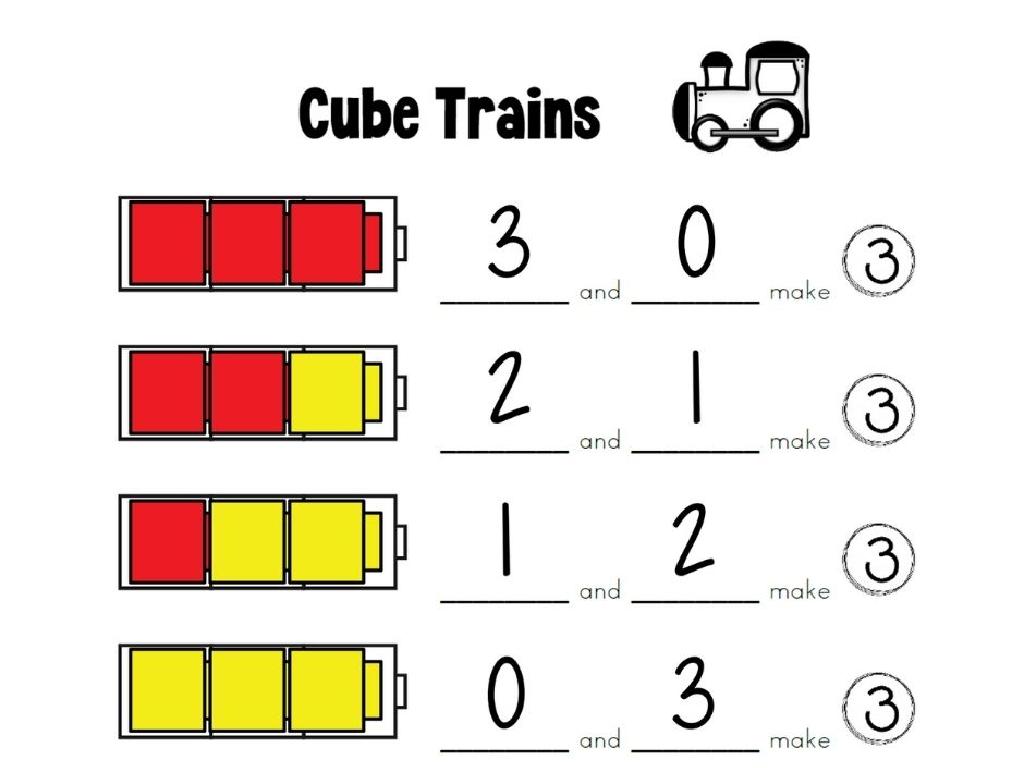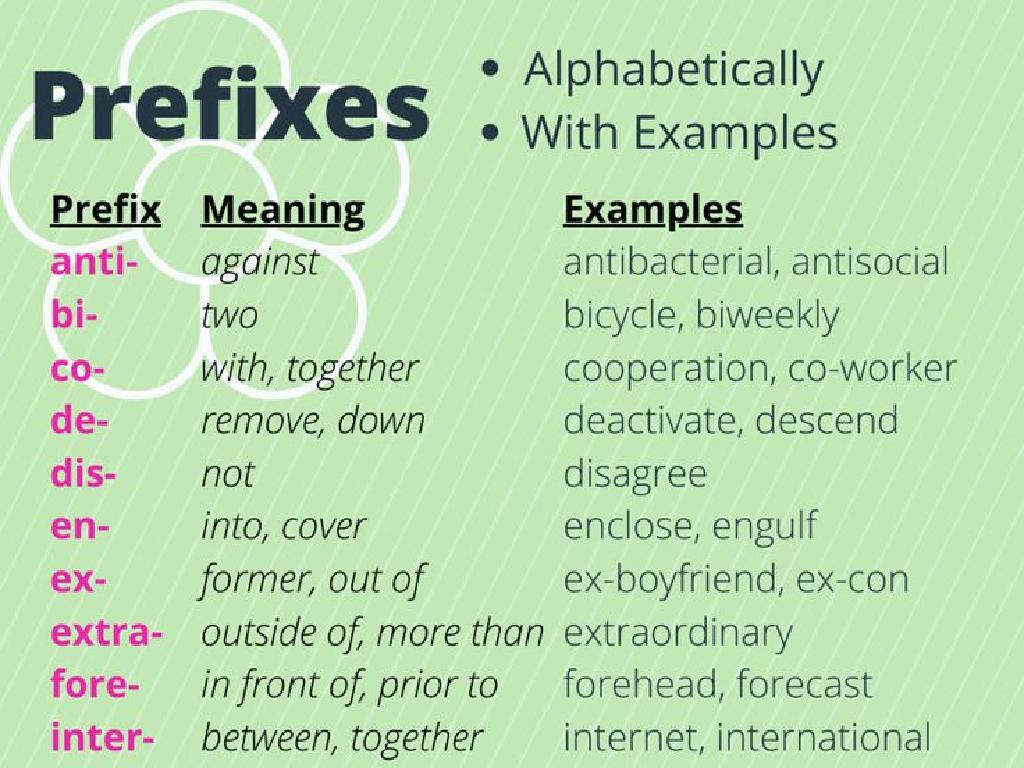Find Two Numbers Based On Sum And Difference
Subject: Math
Grade: Fourth grade
Topic: Mixed Operations
Please LOG IN to download the presentation. Access is available to registered users only.
View More Content
Mixed Operations: Sum and Difference
– Welcome to Mixed Operations!
– Review Addition and Subtraction
– Recall how to add and subtract numbers
– Today’s Goal: Find two numbers
– We’ll learn to find two numbers when we know their sum (total) and difference (how much more one is than the other)
– How to determine numbers from sum and difference
– Example: If the sum is 16 and the difference is 4, what are the two numbers?
|
This slide introduces students to the concept of mixed operations with a focus on finding two numbers when their sum and difference are known. Begin by welcoming students and reviewing addition and subtraction to ensure they are comfortable with these operations. The goal for today’s lesson is to apply this knowledge to find two specific numbers based on given information. Explain that the sum is the result of adding two numbers, while the difference is the result of subtracting the smaller number from the larger one. Use simple examples to illustrate this concept, and prepare to guide students through a step-by-step process to solve these types of problems. Encourage students to think critically and to check their work by adding and subtracting the numbers they find to ensure they match the given sum and difference.
Understanding Sum: Finding Numbers
– What is a Sum?
– Sum is the result of addition
– Adding two numbers
– Example: 7 + 3
– When we add 7 and 3 together
– Sum equals 10
– We get the total, which is 10
|
This slide introduces the concept of sum to the students. Begin by explaining that a sum is the result we get when we add two numbers together. Use simple examples, like adding 7 and 3, to illustrate this point. Make sure to demonstrate the process on the board, showing that when we combine these two numbers, the total amount is called the sum, which in this case is 10. Encourage the students to think of other number combinations that add up to 10, and ask volunteers to share their examples with the class. This will help solidify their understanding of the concept of sum in the context of addition.
Understanding Difference in Numbers
– Define the term ‘difference’
– The ‘difference’ is the result of subtraction
– How to find a difference
– Subtract the smaller number from the larger one
– Example of finding a difference
– 10 minus 7 equals 3, so the difference is 3
|
This slide is aimed at helping fourth-grade students grasp the concept of ‘difference’ in the context of subtraction. Begin by defining the term ‘difference’ as the result you get when you subtract one number from another. Emphasize that to find the difference, you always subtract the smaller number from the larger number. Provide a clear example, such as subtracting 7 from 10, to illustrate the concept. The difference is 3. Encourage students to think of ‘difference’ as the distance between two numbers on a number line. This will help them visualize the concept better. In the next class, practice with more examples and possibly introduce word problems that involve finding the difference.
Mystery of Numbers: Sum and Difference
– Understanding sum and difference
– Sum means adding two numbers, difference means subtracting them.
– Using clues to find numbers
– Think like a detective using hints to find two secret numbers.
– Example: Sum is 16, difference is 4
– What two numbers add up to 16 and when subtracted give you 4?
– Solving the number mystery
– Use addition and subtraction to find the two mystery numbers.
|
This slide introduces the concept of finding two numbers when their sum and difference are known. Start by explaining that the sum is the result of adding two numbers, while the difference is the result of subtracting them. Present the problem as a mystery where clues (sum and difference) are used to find the missing numbers. For example, if the sum of two numbers is 16 and their difference is 4, students can work out that the numbers are 10 and 6. Encourage students to set up equations to solve these problems systematically. This activity helps enhance their critical thinking and problem-solving skills in arithmetic.
Finding Numbers from Sum and Difference
– Add sum and difference, divide by 2
– (16 + 4) / 2 gives us the larger number
– Subtract difference from larger number
– 10 – 4 gives us the smaller number
– Example: Sum is 16, Difference is 4
– Our numbers are 10 and 6!
|
This slide is aimed at teaching students how to find two numbers when given their sum and difference. Start by explaining that the sum of two numbers is the total you get when you add them together, and the difference is what you get when you subtract the smaller number from the larger one. Use the example provided to illustrate the process: by adding the sum (16) and the difference (4) and then dividing by 2, students can find the larger number (10). Then, by subtracting the difference (4) from the larger number (10), they can find the smaller number (6). Encourage students to practice this method with different sums and differences to solidify their understanding.
Practice Time: Find the Numbers!
– Solve for two numbers with clues
– Work in pairs for fun collaboration
– Clue 1: Sum is 20, Difference is 8
– What two numbers add up to 20 and have a difference of 8?
– Clue 2: Sum is 30, Difference is 10
– What two numbers add up to 30 and have a difference of 10?
|
This slide is designed for a classroom activity where students work in pairs to apply their understanding of mixed operations to find two numbers based on given sums and differences. For Clue 1, guide the students to think of numbers that when added equal 20 and when subtracted equal 8. For Clue 2, the same approach applies with the numbers adding up to 30 and subtracting to 10. Encourage students to use trial and error with different number combinations. Provide hints if necessary and ensure each pair discusses their thought process. After the activity, discuss the solutions as a class to reinforce the concept.
Math Detectives: Uncover the Secret Numbers
– Team up as Math Detectives
– Receive a mystery with sums and differences
– Use math skills to find two numbers
– Think like a detective: What two numbers add up to the sum and subtract to the difference?
– Present your findings to the class
|
This class activity transforms students into Math Detectives, where they work in pairs to solve a numerical mystery. Provide each pair with a set of clues involving sums and differences, and task them with deducing the two secret numbers that fit the clues. Encourage them to use addition and subtraction skills. Possible activities include: 1) Finding two numbers that add up to 20 and have a difference of 4, 2) Two numbers with a sum of 15 and a difference of 3, 3) A sum of 30 with a difference of 6, 4) A sum of 25 and a difference of 7. After solving the mystery, each pair will share their secret numbers and the strategies they used to find them with the class, fostering a collaborative learning environment.
Math Detectives: Sum and Difference Recap
– Congratulations, Math Detectives!
– Review: Finding numbers by sum & difference
– Sum of two numbers is their total, difference is what you get when you subtract one from the other.
– Recall the steps from today’s lesson
– Step 1: Add the sum and difference. Step 2: Divide by 2 to find the larger number. Step 3: Subtract the difference from the larger number to find the smaller one.
– Practice: More mystery number challenges
– Keep practicing with different sums and differences to become a sum and difference expert!
|
This slide serves as a conclusion and a recap for the lesson on finding two numbers based on their sum and difference. It’s important to praise the students for their hard work and reinforce the key concepts. Go over the method once more, emphasizing the steps: adding to find the total, dividing by two to find the larger number, and subtracting the difference to find the smaller number. Encourage students to continue practicing these steps with different numbers to solidify their understanding. Provide additional practice problems for homework or in-class work to further reinforce the concept.



/mla_works_cited_format.png)


